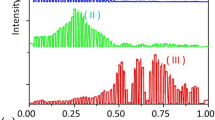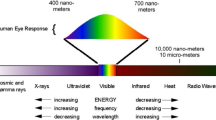Abstract
Optical skyrmions have recently been constructed by tailoring vectorial near-field distributions through the interference of multiple surface plasmon polaritons, offering promising features for advanced information processing, transport and storage. Here, we provide experimental demonstration of electromagnetic skyrmions based on magnetic localized spoof plasmons (LSP) showing large topological robustness against continuous deformations, without stringent external interference conditions. By directly measuring the spatial profile of all three vectorial magnetic fields, we reveal multiple π-twist target skyrmion configurations mapped to multi-resonant near-equidistant LSP eigenmodes. The real-space skyrmion topology is robust against deformations of the meta-structure, demonstrating flexible skyrmionic textures for arbitrary shapes. The observed magnetic LSP skyrmions pave the way to ultra-compact and robust plasmonic devices, such as flexible sensors, wearable electronics and ultra-compact antennas.
Similar content being viewed by others
Introduction
Skyrmions - topologically stable three-dimensional (3D) vector field configurations confined within a two-dimensional (2D) domain - have been prompting significant interest in a number of physical systems, including elementary particles1, Bose-Einstein condensates2, nematic liquid crystals3, and chiral magnets4,5. Beyond elementary skyrmion, nested multiple skyrmions have also been demonstrated in magnetic materials, such as the skyrmionium6,7,Full size image
The space-coiling cylinder can be modeled as a homogeneous rod with extremely anisotropic properties (Supplementary Fig. S3), with an anisotropic permittivity tensor with infinite azimuthal- and z-oriented components while staying finite in the radial direction. This extreme form of anisotropy supports quasi-static modal distributions, having a radially polarized electric E-field and an azimuthal surface current J, in contrast to conventional magnetic Mie resonators where E is typically parallel to J29. Such exotic resonant mode supports extreme field enhancement (Fig. 2b), as high as 105 in the geometry of Fig. 2a (inset). Figure 2c shows the linear dependence of the resonant frequency (k0R) and resonant linewidths (Δk0R) with the mode index, confirming its equidistant response. Figure 2d shows that the field confinement factor (resonant wavelength over cavity radius) of the fundamental mode linearly increases with nr, indicating that the resonator compactness can be enhanced by densifying the space-coiling fineness. Figure 2e shows that increasing the meta-structure fineness also increases field enhancement and quality factor, following a quadratic trend. These features are fundamentally limited by the considered finite conductivity of the involved materials, implying a tradeoff between quality factors and material losses studied in Supplementary Figs. S4a, b. Our study shows that realistic metals can support these resonant responses over a wide frequency range, spanning GHz and THz frequencies, as shown in Supplementary Fig. S4c, d.
Now, we consider finite-thickness space-coiling meta-structures to identify the skyrmion nature of their vectorial field configurations. In the 2D geometry, the LSP field profiles only exhibit scalar (H-field) or 2D vectorial (E-field) properties. However, for the 3D space-coiling meta-structure with finite thickness, both H-field and E-field distributions manifest 3D vectorial configurations at the interface between the meta-structure and the surrounding background (Supplementary Fig. S5). With decreasing the 3D space-coiling meta-structure thickness, the resonant behavior and the localization of the field pattern are preserved, with a small frequency shift compared to the 2D scenario (Supplementary Fig. S6)30. The topological properties of the 3D vectorial field configuration can be quantitatively evaluated by the skyrmion number14
where \({{{{{\bf{h}}}}}}=\{{H}_{x},{H}_{y},{H}_{z}\}/|{{{{{\bf{H}}}}}}|\) is the local unit vector of the field, and the integrand \({{{{{\bf{h}}}}}}\cdot (\frac{\partial {{{{{\bf{h}}}}}}}{\partial x}\times \frac{\partial {{{{{\bf{h}}}}}}}{\partial y})\) is the skyrmion density. The skyrmion number is a topological invariant that characterizes the order of topological knots formed by field vectors, i.e., the number of times the field wraps around the unit sphere. The skyrmion number of the magnetic field profile calculated at the air interface (Supplementary Figs. S5a–c and S6b) is equal to 1, confirming a pure skyrmion field configuration.
Experimental observation of LSP skyrmions
To experimentally observe the skyrmion vectorial field configurations, we fabricated an ultra-thin space-coiling meta-structure (h = 0.016 mm, a = 1 mm, d = 1.5 mm, R = 30 mm, nr = 20) over a printed circuit board (Fig. 3a). We scanned the near field of the resonant modes with a 3D scanning platform connected to a vector network analyzer (Fig. 3b). The measured response indeed manifests a multi-resonant spectrum with nearly equidistant sharp peaks (blue curve in Fig. 3c and Supplementary Fig. S18). This feature is consistent with the simulation results with the same geometry parameters (red curve in Fig. 3c). Since these modes are eigen-resonances of the meta-structure, we observe a strong excitation of the skyrmions with the near-equidistant multi-resonant spectrum for various near-fields or far-field sources (Supplementary Fig. S7), in stark contrast with previous skyrmions based on the interference of carefully tailored propagating surface plasmons14,15,16.
a Schematic of the fabricated space-coiling meta-structure. b Experimental setup for near-field scanning of all vectorial magnetic field components of the skyrmion mode. c Measured (blue) and simulated (red) near-equidistant multi-resonant response spectra containing the first five modes. Measured quality factors for those modes are 165, 78, 62, 45, and 34, respectively. d Simulated (upper panel) and measured (lower panel) magnetic field (Hz) profile at the central plane perpendicular to the sample (xz-plane). e Unit vector configuration of magnetic field distribution (upper panel) and cosine of the unit field orientation angle distribution (lower panel) along the radial direction for each mode. Insets in the lower panel show the skyrmion number in each mode lobe, as well as the total skyrmion number.
Because these modes resonate at a deeply subwavelength scale with large radial wavevectors kr ≫ k0, the z-component wavevector \({k}_{z}=-i\sqrt{{k}_{r}^{2}-{k}_{0}^{2}}\) is mostly imaginary, yielding strong field confinement far beyond the diffraction limit. The measured elementary skyrmion has a lateral size dm = λ/100, and a half vertical size hm = λ/400 (Fig. 3d, left-lower panel), leading to an extremely subwavelength mode volume Vm = 2πhm(dm/2)2 = π(λ/2)3/106. We stress that such tiny mode volume is obtained with just nr = 20, limited by our fabrication and measurement setup. Further squeezing may be achieved by increasing nr. We experimentally observe a relatively high Q-factor of 165 (Fig. 3c), yielding a Purcell factor exceeding 107, promising for various applications requiring strong light-matter interactions. Both out-of-plane (Fig. 3d) and in-plane (Supplementary Fig. S8) magnetic fields along the radial direction have been simulated and measured, yielding excellent agreement, except around the center of the sample, where we observe additional field nulls for the lower modes m = 1, 2, due to strong coupling between localized EM fields and the magnetic loop probe.
Due to the axial symmetry of the magnetic field profile, the unit vector can be written as \({{{{{\bf{h}}}}}}(x,y,z)={\{\sin \varTheta (\rho )\cos \varphi ,\sin \varTheta (\rho )\sin \varphi ,\cos \varTheta (\rho )\}}^{T}\), where ρ and φ are coordinates in the polar system and \(\varTheta (\rho )\) is the orientation angle of the unit vector. The skyrmion number of the ith radial mode lobe can be calculated in closed form as
showing that the skyrmion number only depends on the initial and final states of \(\varTheta (\rho )\). Figure 3e shows the unit vectors and \(\cos \,\varTheta (\rho )\) distributions along the radial direction. According to Eq. (2), each radial lobe of the mode profile has a skyrmion number +1 or −1, representing an elementary skyrmion polarized in opposite directions. The accumulated total skyrmion number is 1 for odd modes and 0 for even modes, respectively, building a multiple-π-twist TS constructed by multiple elementary skyrmions9, with rich possibilities to implement various topological configurations of different orders10.
The vectorial nature of the skyrmion modes can be observed in our real-space measurements of all three magnetic field components, shown in Fig. 4. The in-plane fields are along the radial direction, Hx and Hy reveal a nodal-line profile along their perpendicular axis (y axis and x axis, respectively). At the same time, the out-of-plane component (Hz) has only radial variations, in good agreement with our simulations. The mode lobes are distributed purely along the radial direction, in stark contrast to conventional WGM modes with multiple azimuthal modes. The three field components form a hedgehog-like vector configuration (bottom panel of Fig. 4), which is the direct signature of Neel-type skyrmions31. This outcome is also confirmed by the skyrmion density and skyrmion number extraction from the field patterns (Supplementary Figs. S11 and S13a).
a–e Upper panels: Simulated and measured 3D vectorial components of magnetic field (Hx, Hy, Hz) patterns; Bottom panel: unit vector field configurations of the EM skyrmion modes, of mode index (a) m = 1, (b) m = 2, (c) m = 3, (d) m = 4, and (e) m = 5, respectively. Max in the color bar represents the maximum amplitude of the field pattern.
In contrast to the full skyrmion supported by the H-field, the E-field profile shows a skyrmion configuration with an extra-π/2-twist, yielding a total skyrmion number of 1/2 (Supplementary Fig. S9)32,5a–c. Even though the geometries are drastically different, their EM response manifests similar near-equidistant multi-resonant spectra. The spatial profiles of all vectorial magnetic field components of these modes for different shapes are directly measured by our near-field scanning technique (as shown in Supplementary Figs. S15–S17), which agree well with the simulation results, manifesting arbitrarily shaped skyrmion textures indicated by the extracted skyrmion number from the arbitrarily shaped mode profile (Supplementary Fig. S14a). Based on the three field components, we reconstruct their vectorial field configurations in the right panels of Fig. 5a–c, showing multiple nested rings adapting their shapes, with multiple-π-twists from the geometry center to the periphery. Such arbitrarily shaped skyrmion configurations have been long-sought in various systems5, providing a unique way to realize flexible skyrmions for applications in various technological areas. In addition to continuous shape deformations, we also studied the effect of abrupt defects introduced within the meanderline geometry (Supplementary Note 7 and Fig. S19), particularly in the forms of gaps or shorts in the line. These results show that, as long as the defect does not abruptly modify the field continuity, the structure’s skyrmion nature is preserved.
Measured near-equidistant multi-resonant response spectra, geometry schematics (left-most panels) and vector field configurations with out-of-plane components illustrated by colors and in-plane components by arrows (right 5 panels) for different geometries: (a) ellipse, (b) square, (c) heart-shape. Max in the color bar represents the maximum amplitude of the field pattern.








